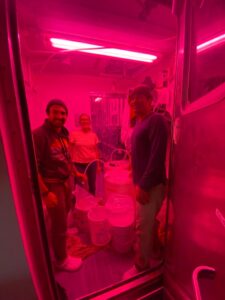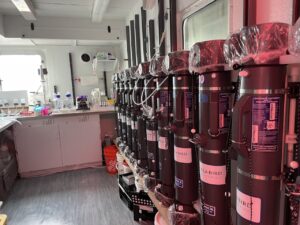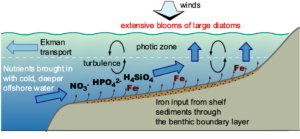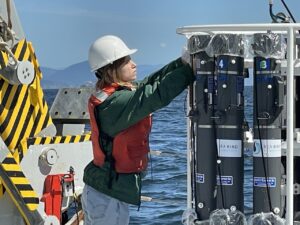Sunday, June 04, 2023 – Offshore North Pacific Coast (Latitude: 41.30.335 N, Longitude: 124.57.022 W)
Even Phytoplankton Need an Iron Boost

Conducting research on a ship made of steel requires some unique protocols when your research team is monitoring concentrations of iron in the seawater during the upwelling event. The Trace Metal Team is from California State Polytechnic University, Humboldt and comprised of Claire Till (co-chief scientist on the research cruise), Shelby Bishop (undergraduate), Matt Hurst (professor). The team is monitoring the iron concentrations in our region of study. Shelby is monitoring the concentration of iron dissolved in water (dissolved iron) and Matt is monitoring larger particles of iron, or particulate iron. The team conducts their Trace Metal research separately from the other scientists, tucked away in their own little cube on the back of the R/V Sally Ride to minimize the ship’s interference with their samples. (See Figures 26, 27)

Phytoplankton, and more specifically diatoms, respond differently when their ocean environment becomes limited for iron. Iron is an important micronutrient for diatoms and iron’s role as a nutrient in the aquatic food web is a key factor in the ocean’s iron cycle.


During an upwelling event, iron can be pushed toward the surface with the other nutrients (discussed earlier in this log). An abundance of upwelled nutrients becomes an open buffet for all the phytoplankton hanging out at the sunlit surface and the feast continues until the nutrients, including the micronutrients like iron that is dissolved in the water, are depleted or the upwelling current subsides. Iron that has been “harvested” by microbes during the upwelling becomes particulate iron and sinks. Unused dissolved iron may also attach to other particles in the water column and sink as well, thus contributing to the iron cycle as the bloom ends. The Trace Metal team collects seawater each time the other researchers launch a CTD and transport their bottles to the Trace Metal Lab for filtering. Shelby collects the dissolved iron that passes through the filter and Matt captures the larger particulate iron that is too large to pass through the filter. The concentrations they measure will provide a “map” for the other research teams to assist in them tracking the strength and duration of the upwelling plume.
